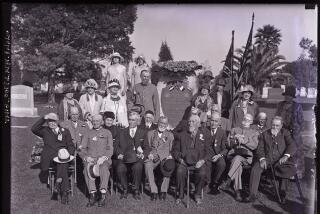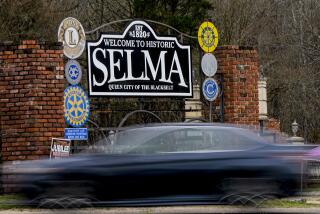Amid Changing Times, Selma Has Lost a Civil War Battle
SELMA, Ala. — James Hammonds looked stoic as he surveyed Selma’s Civil War battlefield, but he could not resist a sigh: The trenches’ gray planks had buckled, leaving gaps in the city’s defenses.
Hammonds, who 19 years ago came up with the idea of reenacting Selma’s place in Civil War history, now fears that his town is losing another battle.
Almost 141 years after a ragtag Confederate army struggled to defend Selma against Union forces, historical reenactors have canceled this year’s Battle of Selma.
Like their Confederate forebears, the reenactors lacked manpower.
Fewer than 200 reenactors had registered for this month’s battle -- a far cry from the 2,000 who took part in 1995, the battle’s 130th anniversary.
“We’ve had to beat the bushes for reenactors,” said William G. Rambo, chief military commander of the Battle of Selma.
Changing demographics in a city that was a flashpoint in the civil rights movement as well as the Civil War, and competing visions of just how authentic a battlefield reenactment should be -- even the high cost of gasoline -- are cited as factors in the declining interest.
Although organizers attributed the cancellation of the Battle of Selma to a national decline in Civil War reenactments, many Alabama reenactors said they stopped attending because it had become too elitist.
“It was getting to the point where we weren’t exactly welcomed with open arms,” said Roger Brothers, captain of the 62nd Alabama unit, who decided to skip this year’s battle for the first time in 18 years. He will travel more than 200 miles to another reenactment, in Kennesaw, Ga.
“The stitch-counters had taken over,” he said. “If you didn’t have what they considered to be the sufficient authentic kit, they looked down their noses at you.”
The purist reenactors -- called stitch-counters because of their insistence that buttonholes be hand-sewn and have a historically accurate thread count -- have become more vocal in their quest for strict authenticity.
Ken Sumner, brigadier general and president of the Alabama Division of Civil War Reenactors Inc., said he stopped attending the Battle of Selma several years ago after some of his units were excluded.
Throughout the 1990s, the Selma battle commander imposed stricter standards on reenactors -- making the event invitation-only and upping the requirements for authentic garb. Cowboy hats, sunglasses and modern-day combat boots were no longer welcome. Confederate reenactors are now asked not to wear sky-blue wool trousers, but the more historically authentic butternut-colored wool and cotton jean cloth.
Town businessmen originally conceived of the battle as an event that would revive Selma’s depressed economy. The town, which is on a bluff overlooking the Alabama River, was reeling from the demise of manufacturing and the migration of many residents to other towns.
With gusto, locals built a system of wooden trenches, with three full redoubts and two embrasures on a portion of the original battlefield. Each year, they erected a wood house and planted pine trees to blow up during the battle.
They also held a ball at Sturdivant Hall, a Greek-revival antebellum mansion, and encouraged reenactors from across the country to bring their families.
Civil War history, though, is less relevant to Selma today. It is now a predominantly African American town -- according to the 2000 census, its population of about 20,000 is 69% black -- that is led by an African American mayor. And it is famous for a modern battle: the 1965 standoff between voting rights marchers and state troopers on Edmund Pettus Bridge.
George “Cap” Swift, who opened the Selma Visitor Information Center in the front room of his home the same year that reenactors held the first Battle of Selma, says his best-selling product is a T-shirt commemorating the Edmund Pettus Bridge.
His back room, which was once devoted to Civil War books, is now stacked with “Profiles of Great Black Americans” and “Faces of Freedom Summer.”
“The world has changed a lot in 19 years,” Swift said.
Though Selma’s Tourism and Convention Bureau has packaged the town as a destination for Civil War and civil rights history, the emphasis has gradually shifted toward civil rights.
The U.S. Department of Transportation recently announced it would provide more than $500,000 for a Selma Interpretive Center across the street from the Edmund Pettus Bridge.
Lauri Cothran, executive director of the bureau, said that the cancellation of the Battle of Selma was regrettable but that it would not badly harm the town’s burgeoning tourism industry.
“It’s not the death knell to tourism in Selma, Ala.,” she said. “The history of Selma is here whether [or not] reenactors have reenactments.”
Yet with the 150th anniversary of the beginning of the Civil War just five years away, Alabama’s tourism board is eager to revive the Battle of Selma, which it considers the most significant of the state’s 20 Civil War reenactments. It plans to offer financial help to the volunteers.
“The people who celebrate Southern heritage are an independent lot,” said Lee Sentell, Alabama’s tourism director. “We want to help them. People across the country are interested in these events. It’s too early to say that the Civil War is disappearing.”
Even with financial assistance, the future of the Battle of Selma remains uncertain.
Although Rambo, the battle commander, remains committed to imposing stricter regulations on reenactors, locals are now concerned with reviving the popularity of the event.
Hammonds, the man who two decades ago came up with the idea, hopes reenactors will begin to renegotiate battlefield rules.
“It’s fine to be authentic,” he said. “But the Battle of Selma is not about buttonholes.”
More to Read
Sign up for Essential California
The most important California stories and recommendations in your inbox every morning.
You may occasionally receive promotional content from the Los Angeles Times.











